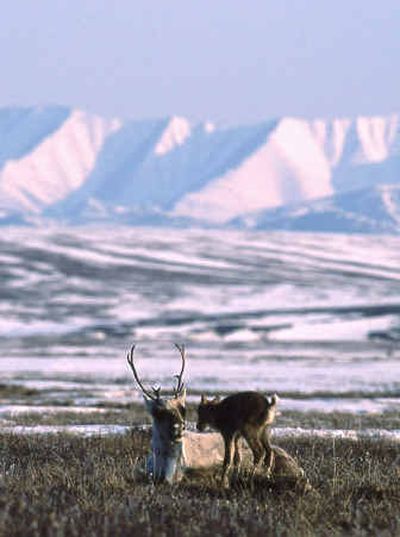Senate Republicans push Arctic Refuge drilling

WASHINGTON — A Senate showdown over an Alaska wildlife refuge is expected within weeks as Republicans plan to use a budget measure to overcome strong opposition to allow oil drilling in the protected area.
It will be first big environmental issue facing the new Congress.
Republican leaders indicated Tuesday that they plan to press the issue of drilling in Alaska’s Arctic National Wildlife Refuge as part of a so-called budget reconciliation process, which cannot be subject to a Democratic filibuster — a tactic that has blocked the refuge’s development in the past.
Given the wider GOP majority in the Senate, Republicans said they think they have the best chance yet to open the presumably oil-rich but environmentally sensitive Alaska refuge to oil drilling, which has been one of President Bush’s top energy priorities.
Budget Committee Chairman Judd Gregg, R-N.H. said it was reasonable to assume ANWR, as the refuge is commonly called, would be part of the budget measure.
“The president asked for it, and we’re trying to do what the president asked for,” Gregg said Tuesday after meeting privately with Republicans on his panel.
Sen. Pete Domenici, R-N.M., chairman of the Energy Committee and a strong supporter of refuge oil development, said he was “very optimistic we’re going to get the ANWR provision in this budget.”
Gregg’s panel was expected to begin work on the budget measure next week. Senate floor action — including a vote on the ANWR provision — was likely before the congressional Easter recess March 19.
A small group of senators and key administration officials is flying to Alaska’s North Slope this weekend to try to dramatize their argument that the refuge can be developed in an environmentally sound way, using modern drilling technology. They will visit the refuge and North slope oil drilling activities west of the protected area.
The group includes Interior Secretary Gale Norton, who has been there a number of times; the new energy secretary, Samuel Bodman, making his first trip; James Connaughton, head of the White House Council on Environmental Quality; and GOP Sens. Domenici, John Thune of South Dakota, Jim Bunning of Kentucky and Robert Bennett of Utah.
All are strong supporters of allowing companies to develop the millions of barrels of oil believed to lie beneath the tundra along the refuge’s northern coastal plain.
Environmentalists have been lobbying hard to keep oil rigs out of the refuge’s coastal plain, a breeding ground for caribou, home to polar bears and musk oxen and site of an annual influx of millions of migratory birds.
They concede that this year they face the most difficult challenge in their efforts to protect the refuge.
Development of ANWR’s oil has been approved repeatedly in the House as part of broad energy legislation, only to run into staunch opposition in the Senate from most Democrats and a handful of moderate Republicans.
In 1995, an ANWR drilling provision made it into a budget measure — the same tactic now surfacing again — only to have the bill vetoed by President Clinton, an opponent to drilling.
Bush strongly supports ANWR development. He argued for it in two election campaigns and made it a key part of the energy blueprint issued in 2001 by Vice President Dick Cheney.
But it is Alaska’s congressional delegation that has pushed hardest for opening the refuge as Prudhoe Bay oil production continues to dwindle. In recent years, however, major oil companies have shown only modest interest as they focus on oil projects in other parts of the world.
ConocoPhillips and BP, both companies that have been prominent in Alaska North Slope oil development, have pulled out of Arctic Power, a pro-drilling lobbying group financed by the state of Alaska. ChevronTexaco left the group earlier.
Norton, in an interview with The Associated Press, downplayed the significance of these actions, but she acknowledged some oil companies aren’t as interested in lobbying on the issue as they once were. She said she is confident oil companies would bid on leases.
“You’ve got companies that have facilities 30 or 50 miles from ANWR. It seems like a natural extension” of their current North Slope activities, said Norton, who called getting at the refuge’s oil “a national security issue.”
However, government scientific data doesn’t necessarily support that statement.
Using information from the U.S. Geological Survey and Congressional Budget Office, the Energy Information Administration has estimated that at peak production ANWR would produce about .7 percent of world oil production, too little to have any impact on oil prices.
EIA said ANWR oil would never meet more than 3 percent of U.S. oil consumption.
(AP writers Alan Fram and John Heilprin and Spokesman-Review Outdoors editor Rich Landers contributed to this report.)